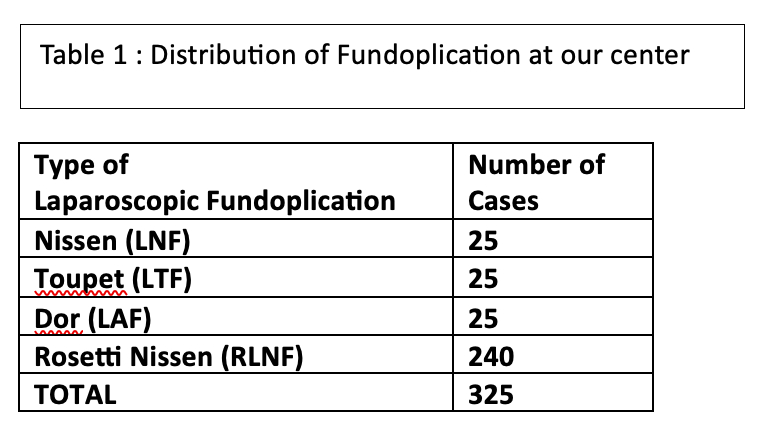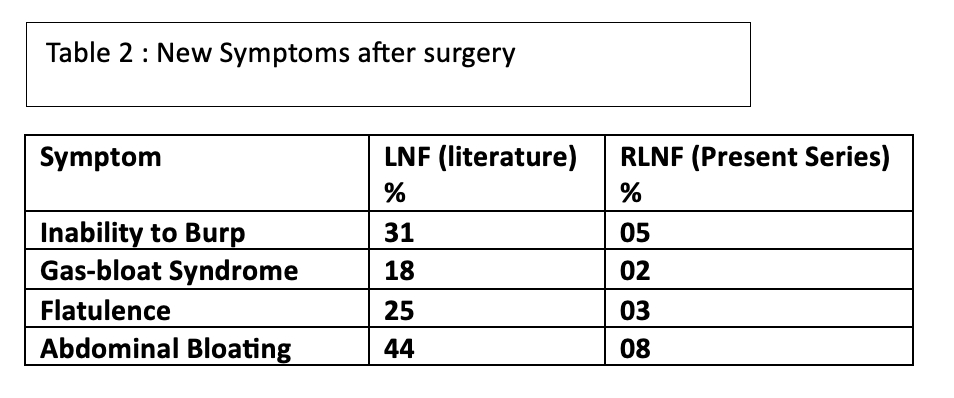Back to 2024 Abstracts
A NON-RANDOMIZED COMPARISON OF FUNDOPLICATION PROCEDURES IN INDIAN POPULATION - ROSETTI NISSEN FUNDOPLICATION HAS THE BEST OUTCOME: A SINGLE CENTER EXPERIENCE FROM A UNIVERSITY TEACHING HOSPITAL
Pawanindra Lal
*1, Atulanand Shirodkar
1, Sri Saran Manivasagam
1, Tusharindra Lal
21Surgery, Maulana Azad Medical College, New Delhi, Delhi, India; 2Sri Ramachandra Institute of Higher Education and Research (Deemed to be University), Chennai, Tamil Nadu, India
Background:Laparoscopic Nissen Fundoplication is considered the gold standard surgical procedure and reamins the most widely performed fundoplication for the treatment of GERD. However, it is complicated by a number of unwanted functional disorders such as dysphagia and gas bloat syndrome. Rossetti fundoplication with minimal dissection of the hiatus and preservation of the short gastric vessels has been preferred for avoidance of some of the new symptoms. The index study was designed to evaluate laparoscopic fundoplication in proven cases of GERD and to compare the benefits and complications between various types of fundoplication. fferent types of fundoplication.
Methods:A total of 650 patients symptomatic for GERD and with esophagitis on Esophago-duodenoscopy were evaluated by Demeester score (DS) and Modified Visick Grade (MVG). Upper G.I. Swallow studies, Esophageal manometry and 24 hour pH metry were done in all patients. A total of 325 patients out of a cohort of 650 patients with GERD symptoms, meeting the criteria for surgery (Symptoms, Endoscopy and pH metry suggestive of GERD) were operated. First 25 patients having reflux on 24 hour pH metry underwent Laparoscopic Nissen Fundoplication and subsequent 25 patients underwent Laparoscopic Toupet fundoplication (LTF). The next 25 patients underwent Laparoscopic anterior fundoplication (LAF). Subsequently, all the patients were operated by the Rossetti modification of Nissen's fundoplication (RLNF) (Table 1). Dor anterior wrap (LAF) was performed in 10 patients where RLNF could not be performed due to a small gastric fundus. All patients were followed up postoperatively at 1,3 and 6 weeks. Esophageal manometry and 24-hour pH metry were done at 6 weeks to confirm the resolution of reflux.
Results:Patients in all groups reported significant improvement in GERD symptoms. In the LNF group five patients had early onset dysphagia that improved within six weeks. Two patients developed pneumothorax and one patient had subcutaneous emphysema of abdomen, chest and neck that resolved spontaneously in a week. The mean duration of surgery was significantly longer in LTF (110min) as compared to LNF (86min), LAF (90 min), RLNF (70 min). There was no conversion to open surgery and no mortality in any group. Inability to burp, gas bloat syndrome, flatulence and abdominal bloat appeared as new symptoms were compared in LNF versus RLNF (Table 2). All the symptoms were significantly reduced in the RLNF group. These symptoms resolved in 3-12 months with medical management in most cases in the LNF group.
Conclusions: All four types of Laparoscopic fundoplications proved are effective in the management of GERD in the Indian population. Based on the results, Rosetti modification of Nissen fundoplication appears to be the favoured procedure in view of both resolution of GERD and reduced incidence of new symptoms.

TABLE 1: DISTRIBUTION OF FUNDOPLICATION

TABLE 2: NEW SYMPTOMS AFTER SURGERY
Back to 2024 Abstracts

